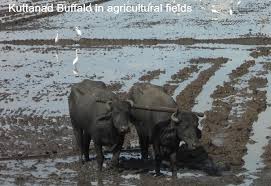Kuttanad
Kuttanad buffaloes are found only in Kuttanad area of Kerala, comprising two districts namely Kottayam and Alappuzha. The buffaloes are best workers in paddy field where use of tractors and tillers are difficult as the fields are mostly submerged in water and having thicker muddy layer (Anil Kumar, 2004). They are poor milkers and the buffalo cows are used only for producing the calves and most of the milk is fed to the male calves, which would become a good work bullock.
- The coat colour of most of the Kuttanad buffaloes are described as grey; but a few with black coloured coats.
- The most important character which distinguishes Kuttanad buffaloes is the presence of two white lines, one at brisket region and the second seen in the upper part of ventral side of neck.
- The marking in the brisket region is large and extends between the two armpits.
- The marking at the upper neck area is short and is seen in the joining of neck with head. The farmers consider these white markings as the mark of purity of the animal.
- The buffaloes are mostly medium-sized.
- The average girth of the Kuttanad buffaloes was measured as 162.32 ± 1.18 cm and height of the buffaloes averaged 109.02 ± 0.78 cm. The average body length was 111.01 ± 1.12 cm.
Milk production in Kuttanad buffaloes is meagre, yielding 1 to 2 litres per day. They are usually milked only once and major part of the milk is given to male calves, hence proper recording of milk is not possible.
One of the major constraints of the farmers is the non-availability of good quality bulls. The farmers practise castration of male buffalo calves and sell them as bullock to fetch more returns, instead of maintaining bulls. In some areas, the buffalo cows are bred with Murrah semen through Government agencies. Facilitating the supply of semen of Kuttanad buffaloes would save the purity of the germplasm. Further, the population of Kuttanad buffaloes is estimated to be around 500 in numbers. Hence, efforts are to be taken to conserve these animals. Conservation efforts are taken by the NGO, such as Vechur trust, who encourage the local farmers to keep these buffaloes in the purest form.

